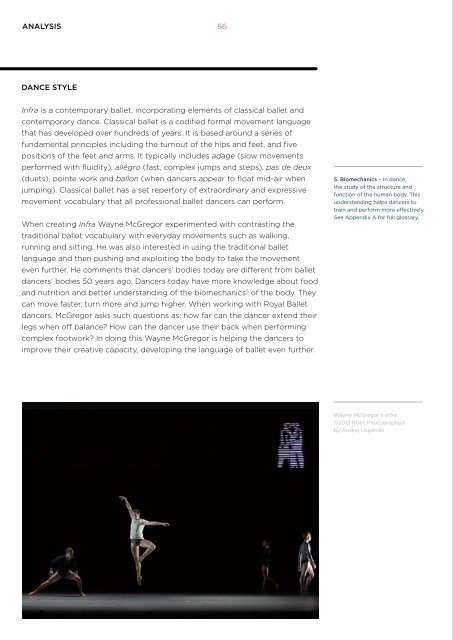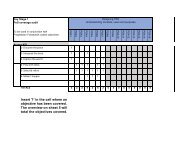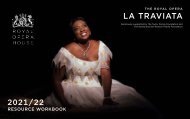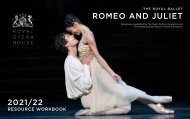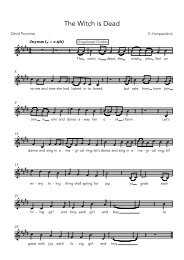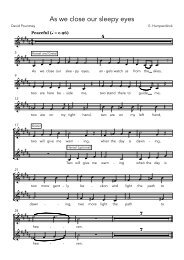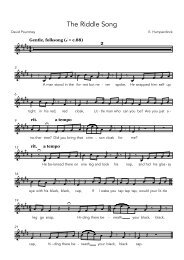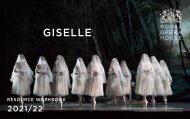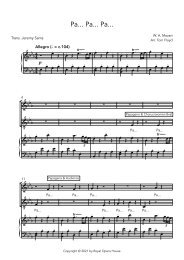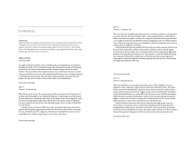Infra E-resource pack 2018
You also want an ePaper? Increase the reach of your titles
YUMPU automatically turns print PDFs into web optimized ePapers that Google loves.
ANALYSIS<br />
56<br />
DANCE STYLE<br />
CHOREOGRAPHIC DEVICES<br />
<strong>Infra</strong> is a contemporary ballet, incorporating elements of classical ballet and<br />
contemporary dance. Classical ballet is a codified formal movement language<br />
that has developed over hundreds of years. It is based around a series of<br />
fundamental principles including the turnout of the hips and feet, and five<br />
positions of the feet and arms. It typically includes adage (slow movements<br />
performed with fluidity), allégro (fast, complex jumps and steps), pas de deux<br />
(duets), pointe work and ballon (when dancers appear to float mid-air when<br />
jumping). Classical ballet has a set repertory of extraordinary and expressive<br />
movement vocabulary that all professional ballet dancers can perform.<br />
When creating <strong>Infra</strong> Wayne McGregor experimented with contrasting the<br />
traditional ballet vocabulary with everyday movements such as walking,<br />
running and sitting. He was also interested in using the traditional ballet<br />
language and then pushing and exploiting the body to take the movement<br />
even further. He comments that dancers’ bodies today are different from ballet<br />
dancers’ bodies 50 years ago. Dancers today have more knowledge about food<br />
and nutrition and better understanding of the biomechanics 5 of the body. They<br />
can move faster, turn more and jump higher. When working with Royal Ballet<br />
dancers, McGregor asks such questions as: how far can the dancer extend their<br />
legs when off balance? How can the dancer use their back when performing<br />
complex footwork? In doing this Wayne McGregor is helping the dancers to<br />
improve their creative capacity, developing the language of ballet even further.<br />
5. Biomechanics – In dance,<br />
the study of the structure and<br />
function of the human body. This<br />
understanding helps dancers to<br />
train and perform more effectively.<br />
See Appendix A for full glossary.<br />
Wayne McGregor’s <strong>Infra</strong>.<br />
©2012 ROH. Photographed<br />
by Andrej Uspenski<br />
Motif and Devlopment<br />
With <strong>Infra</strong> motifs were developed from a prosaic, pedestrian language<br />
exploring what people do everyday such as walking, running, sitting and<br />
gestural actions. These actions were developed further to make richer<br />
movement. This was then contrasted with the more traditional and codified<br />
ballet movement vocabulary. McGregor pushes the classical language to its<br />
extreme, particularly with the use of the back and extensions of the legs.<br />
Manipulation of number<br />
Wayne McGregor invites the audience to individually select what they<br />
would like to watch. It is more like an accidental way of seeing reflecting our<br />
experience in everyday life; the audience will not see everything with one view.<br />
Sometimes all 12 dancers are on stage dancing at the same time and this is<br />
contrasted with a solo or duet performing on their own or in the foreground<br />
while other dancers perform minimal movement in the background.<br />
Contrast<br />
Wayne McGregor experiments with contrasting the mood/energy and<br />
number of dancers throughout the piece.<br />
Climax<br />
The climax of the piece is in section 4. It includes the accumulation of six<br />
male/female duets performed simultaneously in blocks of light, sometimes<br />
in unison. This creates a very clear visual effect showing lots of separate<br />
encounters happening simultaneously, sometimes involving the same activity<br />
and sometimes completely different but each couple is unaware of what is<br />
happening through the other window. There is also a climax in the music in<br />
section 6b that is matched with the intense energy and complex spatial<br />
pathways of the movement.<br />
Highlight<br />
There are a number of highlights in <strong>Infra</strong>. One happens in section 7b towards<br />
the end when the stage is filled with a crowd of ‘normal’ people walking<br />
like pedestrians in one particular direction. This is contrasted with a solo<br />
female dancer centre stage moving slowly to the floor, demonstrating grief<br />
and despair.


